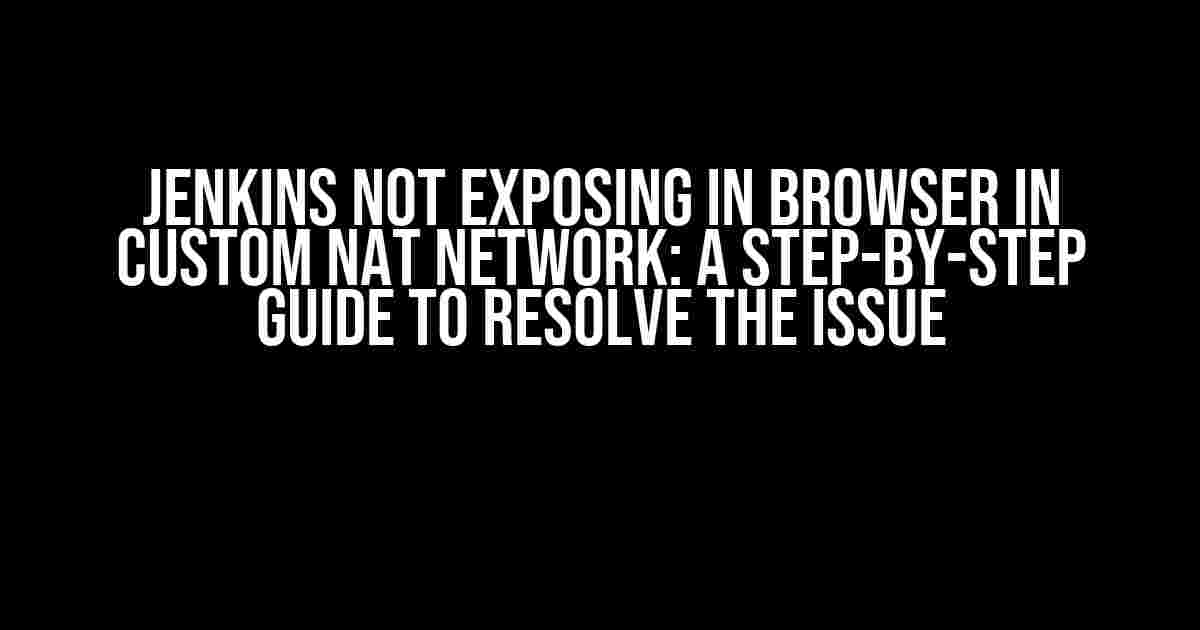Are you frustrated with Jenkins not exposing in your browser, despite being in a custom NAT network? You’re not alone! Many developers face this issue, and it can be a real productivity killer. But fear not, dear reader, for we’ve got you covered. In this comprehensive guide, we’ll walk you through the troubleshooting process, providing clear and direct instructions to get Jenkins up and running in your browser.
Understanding the Problem
Before we dive into the solution, let’s understand the root cause of the issue. When you’re in a custom NAT network, Jenkins may not be exposed to the outside world, making it inaccessible from your browser. This can occur due to various reasons, including:
- Incorrect Jenkins configuration
- Network firewall settings
- Docker containerization issues
- Port forwarding problems
Prerequisites
Before you begin, ensure you have the following:
- Jenkins installed and running on your machine (or a remote server)
- A custom NAT network set up
- A browser of your choice (we’ll use Google Chrome in this example)
- Basic understanding of Jenkins configuration and networking concepts
Step 1: Check Jenkins Configuration
Let’s start by verifying your Jenkins configuration. Follow these steps:
- Access your Jenkins instance and navigate to the
Manage Jenkinspage - Click on
Configure Jenkinsand scroll down to theHTTP/HTTPssection - Verify that the
Jenkins URLis set to the correct address (e.g.,http://localhost:8080) - Ensure that the
HTTP portis set to a port that’s not blocked by your firewall (e.g., 8080)
Note: If you're using a reverse proxy or a load balancer, ensure that the Jenkins URL is correctly configured to point to the proxy/load balancer.
Step 2: Check Network Firewall Settings
Next, let’s examine your network firewall settings:
- Check your firewall logs to see if there are any blocked requests to Jenkins
- Verify that the Jenkins port (e.g., 8080) is allowed in your firewall’s inbound rules
- Check if any other services are using the same port and causing a conflict
Tip: You can use tools liketcpdumporwiresharkto capture and analyze network traffic.
Step 3: Inspect Docker Containerization (If Applicable)
If you’re running Jenkins in a Docker container, ensure that:
- The container is exposing the correct port (e.g., 8080)
- The Docker host’s firewall allows incoming traffic on the exposed port
- The container’s network settings are correctly configured
Example Docker run command:
docker run -p 8080:8080 jenkins/jenkins:lts
Step 4: Verify Port Forwarding
Port forwarding is crucial in a custom NAT network. Ensure that:
- Your router or gateway is configured to forward incoming requests from the external IP to the internal IP (where Jenkins is running)
- The forwarded port is the same as the Jenkins HTTP port (e.g., 8080)
Example port forwarding configuration:
| External IP | External Port | Internal IP | Internal Port |
|---|---|---|---|
| 192.168.1.100 | 8080 | 10.0.0.10 | 8080 |
Step 5: Test Jenkins Connectivity
Now that you’ve checked and configured your Jenkins instance, network firewall, Docker containerization, and port forwarding, it’s time to test Jenkins connectivity:
- Open a new browser window and navigate to the external IP address followed by the Jenkins port (e.g.,
http://192.168.1.100:8080) - If Jenkins is running and exposed correctly, you should see the Jenkins login page
Troubleshooting tip: If you're still unable to access Jenkins, try using a tool liketelnetorncto test connectivity to the Jenkins port.
Conclusion
By following these steps, you should be able to resolve the issue of Jenkins not exposing in your browser in a custom NAT network. Remember to be patient and methodical in your troubleshooting process, and don’t hesitate to seek help if you’re still stuck.
Happy Jenkins-ing!
Bonus tip: Consider using a tool like ngrok to simplify Jenkins exposure and testing in custom NAT networks.
That’s it! You’ve made it to the end of this comprehensive guide. We hope you found it helpful in resolving your Jenkins exposure issue. If you have any further questions or need additional assistance, feel free to ask in the comments below.
Here are 5 Questions and Answers about “Jenkins not exposing in browser in custom NAT network” in HTML format:
Frequently Asked Question
Having trouble accessing Jenkins in your custom NAT network? Don’t worry, we’ve got you covered!
Why can’t I access Jenkins in my custom NAT network?
By default, Jenkins binds to the loopback address (localhost or 127.0.0.1), which makes it inaccessible from outside the NAT network. You need to configure Jenkins to bind to an address that’s accessible from your custom NAT network.
How do I configure Jenkins to bind to a specific IP address?
You can configure Jenkins to bind to a specific IP address by setting the `–httpListenAddress` or `–httpsListenAddress` command-line arguments when starting Jenkins. For example, you can add the following arguments to your Jenkins startup script: `–httpListenAddress=0.0.0.0` or `–httpsListenAddress=0.0.0.0`.
What is the difference between `–httpListenAddress` and `–httpsListenAddress`?
`–httpListenAddress` configures Jenkins to listen on the specified IP address for HTTP requests, while `–httpsListenAddress` configures Jenkins to listen on the specified IP address for HTTPS requests. If you want to access Jenkins using HTTPS, make sure to set `–httpsListenAddress` to the IP address that’s accessible from your custom NAT network.
Do I need to configure the NAT network to access Jenkins?
Yes, you may need to configure the NAT network to forward requests from the public IP address to the private IP address of the machine running Jenkins. This depends on your NAT network setup and the IP address you configured Jenkins to bind to.
What are some common issues to check when Jenkins is not accessible in a custom NAT network?
Common issues to check include: Jenkins binding to the wrong IP address, firewall rules blocking access to Jenkins, NAT network configuration issues, and incorrect URL or port numbers used to access Jenkins.


